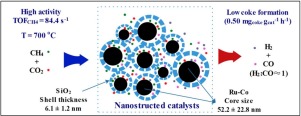Applied Catalysis A: General ( IF 4.7 ) Pub Date : 2018-02-07 , DOI: 10.1016/j.apcata.2018.02.003 Yijun Pang , Yixuan Dou , Aihua Zhong , Wu Jiang , Lingli Gu , Xinzhen Feng , Weijie Ji , Chak-Tong Au

|
In this study, the nanostructured bimetallic Ru-Co catalysts (Ru-Co core particles of ca. 50 nm; SiO2 sell thickness of 6.1 nm, and nRu/nCo = 0.008) were fabricated through the hydrothermal (or impregnation) and modified Stöber processes. The developed catalysts were characterized by means of XRD, N2 sorption, TEM, XPS, TG-MS, and H2-TPR, and evaluated for CO2 reforming of methane to syngas, to establish a detailed structure-performance correlation. The strategy of catalyst design effectively reduced metal sintering at reaction temperatures. Uniform Ru distribution through a hydrothermal approach resulted in more direct Co-Ru interaction, which caused the Co-based cores rather coking- and oxidation-resistant, and induced a phase transformation of β-Co to α-Co under the reaction atmosphere, beneficial for the reaction. The silica shell porosity was modified by applying the CTAB and PVP surfactants in shell encapsulation. In terms of reaction temperature (700 °C), CH4 turnover frequency (84.3 s−1), H2/CO ratio (0.98), and carbon deposition rate (0.5 mgcoke gcat−1 h−1), the currently developed binary Ru-Co catalyst with uniform Ru distribution and improved SiO2 shell porosity is proved to be highly efficient yet durable with a desirable H2/CO ratio for the target reaction. In view of the unique features of catalyst material and the outstanding reaction performance on the basis of CH4 TOF, new insights into the Co-based catalyst for DRM are provided in the current work.
中文翻译:

纳米结构(受电子邮件保护)2:高效且持久耐用,可对甲烷进行CO 2重整,并具有理想的H 2 / CO比
在这项研究中, 通过水热法(或浸渍法)制备了纳米结构双金属Ru-Co催化剂(Ru-Co核芯颗粒约50 nm; SiO 2出售厚度为6.1 nm,n Ru / n Co = 0.008)。修改后的Stöber流程。通过XRD,N 2吸附,TEM,XPS,TG-MS和H 2 -TPR对已开发的催化剂进行表征,并评估其CO 2将甲烷重整为合成气,建立详细的结构-性能关联。催化剂设计策略有效地减少了反应温度下的金属烧结。通过水热法均匀分布的Ru导致更直接的Co-Ru相互作用,这导致Co基核相当耐焦化和抗氧化,并在反应气氛下诱导了β-Co相向α-Co的相变,这是有益的反应。通过在壳包封中应用CTAB和PVP表面活性剂来改善二氧化硅壳的孔隙率。在反应温度(700°C),CH 4转化频率(84.3 s -1),H 2 / CO比(0.98)和碳沉积速率(0.5 mg焦炭g cat -1)方面 h -1),目前开发的具有均匀Ru分布和改善的SiO 2壳层孔隙率的二元Ru-Co催化剂被证明是高效且耐用的,目标反应具有理想的H 2 / CO比。鉴于催化剂材料的独特特性和基于CH 4 TOF的出色反应性能,当前工作提供了对DRM钴基催化剂的新见解。











































 京公网安备 11010802027423号
京公网安备 11010802027423号